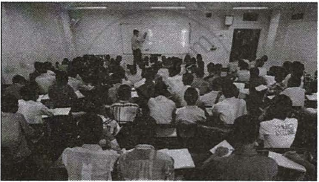Advertisements
Advertisements
Question
For what value of k, the following system of equations will represent the coincident lines?
x + 2y + 7 = 0
2x + ky + 14 = 0
Solution
The given system of equations may be written as
x + 2y + 7 = 0
2x + ky + 14 = 0
The given system of equations is of the form
`a_1x + b_1y + c_1 = 0`
`a_2x + b_2y + c_2 = 0`
Where `a_1 = 1, b_1 = 2, c_1 = 7`
And `a_2 = 2,b_2 = k, c_2 = 14`
The given equations will represent coincident lines if they have infinitely many solutions,
The condition for which is
`a_1/a_2 = b_1/b_2 = c_1/c_2 =. 1/2 = 2/k = 7/14 => k = 4`
Hence, the given system of equations will represent coincident lines, if k = 4
APPEARS IN
RELATED QUESTIONS
Find the value of k for which each of the following system of equations have infinitely many solutions :
2x + 3y = 7
(k + 1)x + (2k - 1)y - (4k + 1)
Solve for x and y:
`9/x - 4/y = 8, (13)/x + 7/y = 101`
Solve for x and y:
`3/x + 6/y = 7, 9/x + 3/y = 11`
Find the value of k for which the system of linear equations has a unique solution:
(k – 3) x + 3y – k, kx + ky - 12 = 0.
If three times the larger of two numbers is divided by the smaller, we get 4 as the quotient and 8 as the remainder. If five times the smaller is divided by the larger, we get 3 as the quotient and 5 as the remainder. Find the numbers.
Places A and B are 160 km apart on a highway. A car starts from A and another car starts from B simultaneously. If they travel in the same direction, they meet in 8 hours. But, if they travel towards each other, they meet in 2 hours. Find the speed of each car.
The cost of 5 pens and 8 pencils together cost Rs. 120 while 8 pens and 5 pencils together cost Rs. 153. Find the cost of a 1 pen and that of a 1pencil.
Find the value of k, if the point P (2, 4) is equidistant from the points A(5, k) and B (k, 7).
Read the following passage:
|
A coaching institute of Mathematics conducts classes in two batches I and II and fees for rich and poor children are different. In batch I, there are 20 poor and 5 rich children, whereas in batch II, there are 5 poor and 25 rich children. The total monthly collection of fees from batch I is ₹9,000 and from batch II is ₹26,000. Assume that each poor child pays ₹x per month and each rich child pays ₹y per month.
|
Based on the above information, answer the following questions:
- Represent the information given above in terms of x and y.
- Find the monthly fee paid by a poor child.
OR
Find the difference in the monthly fee paid by a poor child and a rich child. - If there are 10 poor and 20 rich children in batch II, what is the total monthly collection of fees from batch II?
Find the values of 'a' and 'b' for which the system of linear equations 3x + 4y = 12, (a + b)x + 2(a – b)y = 24 has infinite number of solutions.

